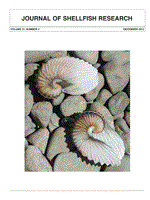Metal concentrations were measured in seawater in the Piedras River estuary (southwest Spain) for 15 mo during 2005 to 2006. A significant sinusoidal seasonal variation of Cu and Zn was observed. The Cu levels were up to 30 µg/L. Effects of Cu concentrations, ranging from 0–100 µg/L, and exposure times of 48 h, 72 h, and 96 h on both mortality and a lethal concentration (LC50) of Venerupis decussata (Linnaeus 1758) larvae were studied. Larval mortality was 100% 96 h after exposure to 100 µg Cu/L, and mobility decreased after exposure to 100 µg Cu/L for 48 h or longer. Lethal concentrations for 48 h, 72 h, and 96 h were set at 190, 97, and 49 µg Cu/L, respectively. Results indicated that Cu concentrations recorded in Piedras River estuary (up to 30 µg/L) did not affect 96-h larval development of V. decussata.
How to translate text using browser tools
1 August 2013
Temporal Fluctuation of Metals in Seawater of the Piedras River Estuary and the Effects of Copper on Venerupis decussata Larvae
P. Ruiz-Azcona,
O. Moreno,
I. Palanco,
I. GiráLdez,
A. Velasco,
E. Morales
ACCESS THE FULL ARTICLE

Journal of Shellfish Research
Vol. 32 • No. 2
August 2013
Vol. 32 • No. 2
August 2013
clam larvae
copper
heavy metals
Piedras River estuary
toxicity
Venerupis decussata




